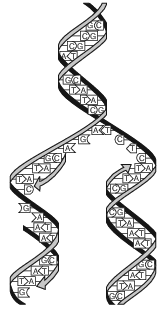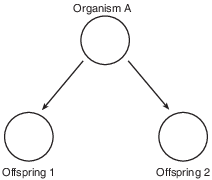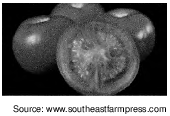Topic: Characteristics Of Traits Transferred To Offsprings
Characteristics Of Traits Transferred To Offsprings
Many years ago, a scientist grew pea plants that produced wrinkled peas. The peas from these plants produced new plants that also produced wrinkled peas. The scientist concluded that something in the parent plants was being transmitted to the next generation. This discovery is now known as
(1) genetic engineering
(2) biological evolution
(3) heredity
(4) natural selection
The process represented in the diagram below occurs in many cells.

The main function of this process is to
(1) provide an exact copy of the genetic code
(2) ensure genetic variation in a species
(3) synthesize cellular proteins
(4) produce antibodies to combat disease
Before they can pass from a parent cell to its offspring cells, the inherited instructions that a human cell carries must first be
(1) moved into the nucleus
(2) broken down and made into DNA molecules
(3) used to make specific protein molecules that form genes
(4) accurately replicated
Changes made during the copying process are represented by * in the diagram.

The process by which a cell copies its DNA before it divides is
(1) mutation
(2) diffusion
(3) replication
(4) respiration
Before a cell divides, an exact copy of each chromosome is made by the process of
(1) genetic engineering
(2) replication
(3) mutation
(4) recombination
Green sea slugs are animals that live in water and have developed the ability to produce their own chlorophyll. These creatures can also pass this ability to make chlorophyll to their offspring. Once the offspring have one meal of algae, they are able to make food using sunlight. This one meal provides the baby slugs with the chloroplasts needed to make use of the chlorophyll, and they are able to produce their own food in the future.
The best explanation for why sea slugs are able to pass on this ability to make food to their offspring is that
(1) the gene for making algae is in all their body cells
(2) making food is beneficial, so the slugs needed to mutate
(3) the environment causes the slugs to become green
(4) the gene for chlorophyll production is part of their DNA
Brothers and sisters often have similar facial characteristics, such as nose shape or eye color, because they
(1) are raised in similar environments
(2) eat similar types of foods
(3) have similar types of proteins
(4) use similar types of facial care products
A lion cub resembles its parents because it inherits genes that produce
(1) DNA identical to all of the DNA found in both parents
(2) proteins identical to all of the proteins found in both parents
(3) ATP identical to some of the ATP found in each parent
(4) enzymes identical to some of the enzymes found in each parent
A significant difference between the effects of the genetic information passed on from asexually reproducing parents to their offspring and sexually reproducing parents to their offspring is the
(1) degree of modification of the size of chromosomes
(2) types of DNA subunits
(3) number of chromosomes in the body cells of the offspring
(4) amount of variation between the parents and the offspring
Aphids, small insects that feed on the sap of plants, undergo asexual reproduction during the summer months. They produce eggs that are formed without the separation of chromosomes. These eggs do not need to be fertilized, and all of the resulting offspring are female.

The best explanation for all of these offspring being female is that
(1) there is not enough food to support male aphids
(2) asexual reproduction produces offspring with many mutations
(3) only the females are able to feed on the sap of the plants
(4) asexual reproduction produces offspring that are genetically identical to the parent
The diagram below represents a form of cellular reproduction.

As a result of this process, offspring 1 and offspring 2 will have
(1) the same number of genes but different traits
(2) a different number of genes but the same traits
(3) the same number of genes and the same traits
(4) a different number of genes and different traits
Female hammerhead sharks sometimes produce offspring by a type of asexual reproduction. These offspring
(1) are a result of the uniting of a male and a fe- male gamete
(2) have cells that contain DNA found only in the female shark
(3) are considered to be a different species from the male parent
(4) have cells that contain genetic information from both parents
Identify one way in which the process of growth of a human embryo is similar to the process of reproduction in a single-celled organism. [1]
Allow 1 credit. Acceptable responses include, but are not limited to:
• — They both involve mitosis.
• — Both processes produce cells containing identical genetic information.
• — The cells are produced asexually.
Transgenic (GMO) Tomatoes
The use of pesticides to control insects costs billions of dollars every year. Genetically modified organisms (GMOs) are an attempt to reduce this cost. Tomato plants that are genetically modified can make proteins that are poisonous to the insects that feed on them. Using these GMO tomatoes would reduce the need for the chemical control of insects.

Identify the process responsible for passing the gene for insect resistance in a leaf cell of a genetically modified tomato plant on to the cells that develop from it. [1]
Allow 1 credit. Acceptable responses include, but are not limited to:
• — mitotic cell division/mitosis
• — asexual reproduction
• — cloning
All organisms need to reproduce for the continuation of their species. Discuss the process of reproduction in humans. In your answer, be sure to:
• identify one hormone present in a female that is involved in regulating the reproductive cycle [1]
• state one way the nucleus of a sex cell is different from the nucleus of a body cell [1]
• state how the normal chromosome number for humans is maintained from one generation to the next [1]
• identify one action by the mother that can influence the development of the embryo and state a result of that influence [1]
The student’s response to the bulleted items in the question need not appear in the following order.
• 15 Allow 1 credit for identifying one hormone present in a female that is involved in regulating the reproductive cycle. Acceptable responses include, but are not limited to:
• — progesterone
• — estrogen
• — LH
• 16 Allow 1 credit for stating one way the nucleus of a sex cell is different from the nucleus of a body cell. Acceptable responses include, but are not limited to:
• — It has half the normal chromosome number/half of the genes.
• — Sex cells are haploid/monoploid.
• — 23 chromosomes in sex cells, 46 in body cell
• 17 Allow 1 credit for stating how the normal chromosome number for humans is maintained from one generation to the next. Acceptable responses include, but are not limited to:
• — The egg and sperm each have half the normal chromosome number, and when they join, it restores the normal number for the species.
• — through the process of gamete production and fertilization
• — Each parent contributes half of the chromosomes.
• 18 Allow 1 credit for identifying one action by the mother that can influence the development of the embryo and stating a result of that influence. Acceptable responses include, but are not limited to:
• — Alcohol use can lead to Fetal Alcohol Syndrome.
• — Smoking can lead to low birth weight.
• — Poor nutrition can lead to underweight babies.
• — Drug use can lead to birth defects.
• — Good nutrition can lead to a healthy baby.
• — Drinking alcohol puts the embryo at risk.
• — Proper prenatal care might detect potential problems early so they can be treated.
